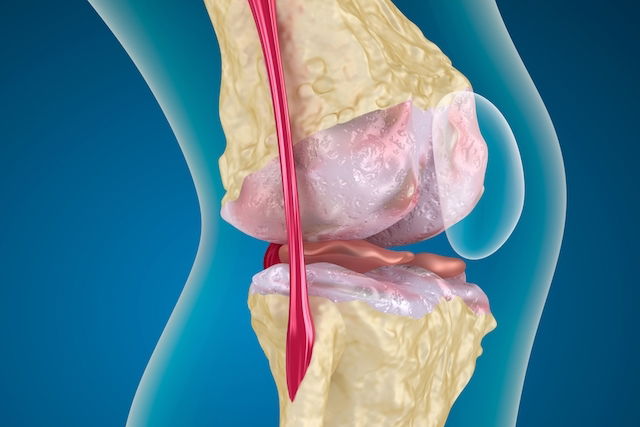Knee arthritis is a condition characterized by wear and tear on the knee joint that leads to inflammation in the area. It is associated with symptoms such as pain, redness, swelling and difficulty moving the knee. Over time, it is natural for arthritis to worsen, causing more serious symptoms such as deformity and intense pain. This can make it difficult to walk and many patients develop a limp as a result.
This situation is more common in older adults, due to the natural wear and tear on the joints. However, knee arthritis can also develop as a result of direct trauma to the knee or inflammatory diseases.
If you experience symptoms of arthritis, you should see an orthopedic surgeon for assessment and testing. If confirmed, the doctor may initiate treatment with medication, physiotherapy and, in the more serious cases, surgery.

Common symptoms
The symptoms associated with knee arthritis include:
- Knee pain after exertion, which may improve with rest
- Stiffness when getting out of bed in the morning or after long periods of rest, which improves after 30 minutes
- Audible or palpable clicks or cracks when moving
- Swelling and heat, which are usually present during an inflammatory phase
- Sensation of an increase in the size of the knee, due to the growth of the bones around the knee
- More limited movements, especially fully extending the knee
- Difficulty weight-bearing
- Weaker and more atrophied thigh muscles.
It is common for both knees to be affected, however the symptoms can differ between them, as the degree of arthritis in each joint can vary.
If you notice these symptoms, you should see an orthopedic diagnosis for assessment and diagnosis. The doctor will identify the possible cause and start the most appropriate treatment.
Confirming a diagnosis
The diagnosis of knee arthritis is made by the orthopedic surgeon based on an assessment of the symptoms presented and a physical examination of the joint. The doctor will guide you though several movements in order to check mobility, assess for the presence of clicks and pain, and pain tolerance. The doctor will also consider the risk factors for knee arthritis, as it is more common in people over 50.
To confirm a diagnosis, the doctor may order imaging tests such as X-rays, CT scans, MRI and/or ultrasound of the knee to assess the degree of wear and tear on the joint. Results will help to guide the most appropriate treatment.
Main causes
The main causes of knee arthritis include:
- Natural wear and tear of the joint, which occurs due to age
- Being overweight
- Direct trauma, such as falling on the knee
- Inflammatory disease associated with improper use of the joint
This condition mainly affects patients over 45, but if you are very overweight or have some of these risk factors, for example, you can develop arthrosis at a younger age, around 30.
Treatment options
Treatment for knee arthritis should be carried out as directed by your doctor, and may differ from patient to patient. The main treatments for knee arthritis include:
1. Medication
The medications indicated by the orthopedist for knee arthrosis are aimed at reducing pain and discomfort in the joint.
The most commonly prescribed medications are:
- Acetaminophen is the first choice treatment indicated to reduce mild to moderate pain
- Opioids, such as tramadol, are indicated for severe pain in more serious cases of knee arthritis;
- Duloxetine, which is used to help relieve pain in cases of chronic pain.
In addition, there are other medications that may be indicated for knee arthritis, such as injecting hyaluronic acid into the joint, or taking a glucosamine and chondroitin sulfate supplement orally. However, more studies are still needed on their use in in the treatment of knee arthritis.
2. Exercises
Some exercises for knee arthritis include stretching the leg muscles, which can be done by the person themselves or with the help of a physiotherapist. Cycling can also be beneficial for mild cases of knee arthritis.
Ideally, however, these exercises should be done under the guidance of a physiotherapist, as performing them incorrectly or when the joint is very sore can aggravate symptoms.
3. Physiotherapy
Physiotherapy for knee arthritis should preferably be carried out every day, when pain is at its highest. The physiotherapist should assess the joint and advise on the best treatment approach, respecting each person's limitations. Physiotherapy sessions can employ the use of specific equipment and stretching, as well as muscle-strengthening exercises.
4. Surgery
Surgery is indicated in cases where medication and physiotherapy have not been effective in relieving symptoms, and when pain persists even after months of conventional treatment.
Surgery can be performed by removing the knee joint and placing a prosthesis in its place. A full recovery is usually possible after surgery. However, physiotherapy sessions are still necessary to speed up recovery.
5. Natural treatment
A great natural treatment for knee arthritis is to use a warm linseed compress on the joint at the end of the day. You can take a clean, thin cloth and 3 tablespoons of linseed to it, folding it over. Heat the compress in the microwave for 1 or 2 minutes until it is warm. Then apply to your knees for 10 to 15 minutes.
An arthritis diet, made up of anti-inflammatory foods, may also be recommended by your doctor.
